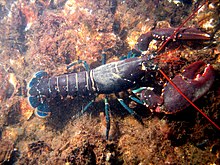Lobsters
| Lobster Temporal range: Valanginian–Recent |
|
|---|---|
 |
|
| European lobster (Homarus gammarus) |
|
| Scientific classification | |
| Kingdom: | Animalia |
| Phylum: | Arthropoda |
| Subphylum: | Crustacea |
| Class: | Malacostraca |
| Order: | Decapoda |
| Infraorder: | Astacidea |
| Family: |
Nephropidae Dana, 1852 |
| Genera | |
|
|
Lobsters comprise a family (Nephropidae, sometimes also Homaridae) of large marine crustaceans.
They have long bodies with muscular tails, and live in crevices or burrows on the sea floor. Three of their five pairs of legs have claws, including the first pair, which are usually much larger than the others. Highly prized as seafood, lobsters are economically important, and are often one of the most profitable commodities in coastal areas they populate. Commercially important species include two species of Homarus from the northern Atlantic Ocean, and scampi – the Northern Hemisphere genus Nephrops and the Southern Hemisphere genus Metanephrops. Although several other groups of crustaceans have the word "lobster" in their names, the unqualified term "lobster" generally refers to the clawed lobsters of the family Nephropidae. Clawed lobsters are not closely related to spiny lobsters or slipper lobsters, which have no claws (chelae), or to squat lobsters. The closest living relatives of clawed lobsters are the reef lobsters and the three families of freshwater crayfish.
Lobsters are invertebrates with a hard protective exoskeleton. Like most arthropods, lobsters must moult to grow, which leaves them vulnerable. During the moulting process, several species change colour. Lobsters have 10 walking legs; the front three pairs bear claws, the first of which are larger than the others. Although lobsters are largely bilaterally symmetrical like most other arthropods, some genera possess unequal, specialised claws.
Lobster anatomy includes the cephalothorax which fuses the head and the thorax, both of which are covered by a chitinous carapace, and the abdomen. The lobster's head bears antennae, antennules, mandibles, the first and second maxillae, and the first, second, and third maxillipeds. Because lobsters live in murky environments at the bottom of the ocean, they mostly use their antennae as sensors. The lobster eye has a reflective structure above a convex retina. In contrast, most complex eyes use refractive ray concentrators (lenses) and a concave retina. The abdomen includes swimmerets and its tail is composed of uropods and the telson.
...
Wikipedia
